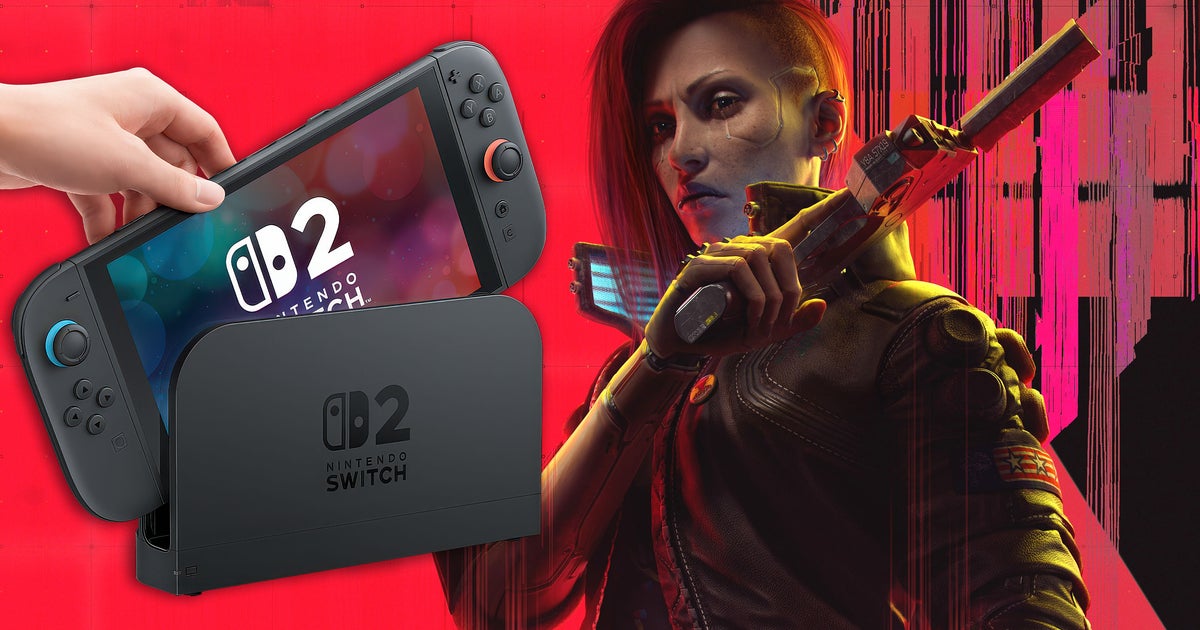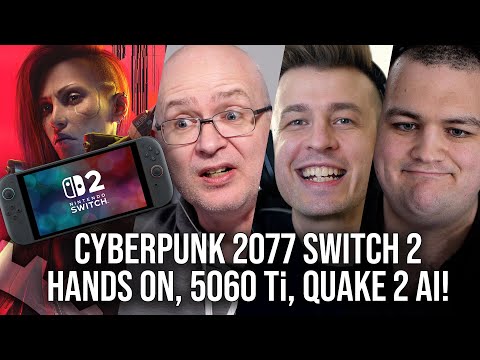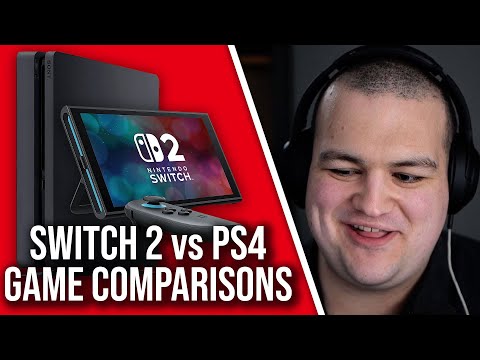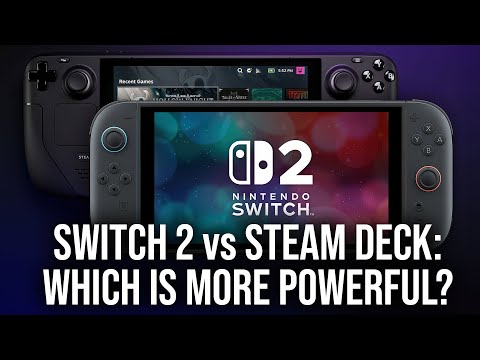Cyberpunk 2077 is a once-in-a-generation kind of game – perhaps the Crysis of its day, the ultimate benchmark title. Yes, you can play it on PS4 or Xbox One with varying levels of effectiveness, but it scales up to challenge even the most powerful PC hardware of the era, up to and including the mighty RTX 5090 – which makes its debut on Switch 2 absolutely fascinating. We’ve known it was coming for some time and it was great to see it feature (albeit somewhat briefly) in Nintendo’s Switch 2 Direct, but now we’ve been hands-on. It’s early days for the port, the version we played is already seven weeks old, but the experience is absolutely fascinating.
And yes, we should clarify that reports that the version on display in Nintendo’s event is the result of seven weeks’ work is a misunderstanding. The game has been in the works for far longer than that. However, the code we saw is indeed a snapshot of the game as it looked almost two months ago – with the game set to release in parallel with Switch 2 itself in seven weeks’ time. The other major topic of debate – whether the game is using Nvidia DLSS – also remains unknown. On site at the Nintendo showcase, a CD Projekt RED representative could neither confirm nor deny.
What I found interesting about the reports from the New York and Paris events (which Digital Foundry did not attend) is how variable reports on Cyberpunk 2077 were. Some say it’s impressive, others were not so kind. The truth is that the mixed response is based entirely on a mixed experience based on the build as it stands. There are times where it is truly impressive, but equally, it’s clear that a good degree of optimisation is required to get a consistent experience – and it may well be that for a launch title at least, Cyberpunk 2077 may simply be ‘too big’ for Switch 2.
- 0:00:00 Introduction
- 0:01:11 News 1: Cyberpunk 2077 tested on Switch 2!
- 0:16:54 News 2: Metal Eden PC demo has issues
- 0:31:04 News 3: Asus teases Xbox PC handheld
- 0:37:59 News 4: RTX 5060 Ti prices allegedly leak
- 0:51:46 News 5: Microsoft launches Muse AI Quake 2 experience
- 1:04:53 News 6: Switch 2 portable mode simulated!
- 1:20:42 Supporter Q1: What will future Nvidia and AMD handhelds look like?
- 1:27:37 Supporter Q2: What will PhysX development look like after being made open source?
- 1:32:00 Supporter Q3: Why doesn’t Switch 2 support 4K120?
- 1:36:16 Supporter Q4: Should Nintendo unlock higher Switch 1 clocks?
- 1:40:43 Supporter Q5: Will Switch 2 run Switch 1 games in their docked configurations in portable mode?
I had access to the build running on both mobile and docked configurations and played with both performance and quality modes. The quality mode targets 1080p resolution, capped at 30fps, while the performance mode apparently targets 1080p at 40fps while docked, while the mobile performance mode attempts 720p at 40fps. What is beyond a shadow of doubt is that we are not talking about native resolution in any case: dynamic resolution is in play. Based on the asset released with Nintendo Direct, a minimum 540p looks likely for mobile play, while docked seems to operate from around 720p to 1080p. Those are highly provisional figures based on the very, very limited footage that has been shared. On-site pixel counting at an event isn’t possible.
Also interesting is that HDR10 is supported – and you’re able to toggle it on and off on the video settings screen. HDR is something that the Nintendo Direct didn’t showcase but it looks great with Switch 2 – the neon highlights on Night City, Dogtown and even on vehicle lights looking very impressive on the mobile screen.
But let’s talk about performance, because this is interesting. Our contention right now is that in terms of rasterisation performance from the GPU, Switch 2 offers capabilities broadly in line with a PS4 when docked – and notoriously, the last-gen versions of the game didn’t perform particularly well. However, CD Projekt RED never released the Phantom Liberty expansion on last-gen systems and yet that’s exactly what the firm showcased at the Nintendo event – it was the only save position provided. The Phantom Liberty expansion represents a step-up in terms of detail compared to the base game – and it’s here that Switch 2 struggles.
Based on the current build, open world traversal in Dogtown hitches and stutters, while big firefights within that open world see frame-rate lurch and stagger. Traversal and open world gunplay posed big challenges for the last-gen consoles and so it is here, with the added complication of more onerous graphical content. The exact same problems manifest in portable play too, perhaps to a greater degree.
However, indoor scenes fare better and I did play some of the base game’s introduction sequence (the Street Kid variant, which kicks off in the bar used for the PC version’s benchmark run) which did seem to suggest that the content was lighter and ran better overall. I can’t help but wonder whether supplying a game save based in a less strenuous area of the game may have improved overall impressions – but at least the Phantom Liberty expansion does give us some idea of the challenges facing the developers as they move into the final weeks of the project.
Those challenges appear to come from two fronts based on what we saw and our knowledge of the existing game running on PC and current-gen consoles. First of all, let’s discuss the frame-rate issues with fast traversal through Dogtown. The same thing happens on consoles and PCs with less capable CPUs and I’d venture to suggest that Switch 2’s CPU limitations are being brought to the forefront. Secondly, combat within the open world with numerous AI entities taxes both CPU and GPU in this game. Take a look at the off-screen footage in this week’s DF Direct and you’ll be able to see this in action.
Elsewhere – for example in the Dogtown black market – there are some performance drops and I’d expect this to be related to GPU limitations, just as it is in the PC version of the game. My take on this is that CDPR is having to navigate twin challenges: maintaining the target 30fps frame-rate in quality mode, while at the same time keeping the lowest bounds of the dynamic resolution scaler reasonably high. One thing of interest is that the dip in performance seen in the Nintendo Direct footage when leaving the black market (a 23fps minimum) was not present when I visited the same area in the demo – which may be down to further optimisation or else different time of day and gameplay conditions. Something else about the choice of Dogtown as the gameplay venue for the demo is that I honestly couldn’t tell the difference between the quality and performance modes. Both could drop frames quite heavily.
Next up, is Cyberpunk 2077 on Switch 2 using DLSS? The on-site CDPR rep didn’t have that information and I’ve put in an email to hopefully find out, but viewers of the new DF Direct may find some of the Switch 2 mobile mode simulation tests I ran on a massively downclocked RTX 2050 interesting. The RTX 2050 is essentially a laptop 3050 with a 64-bit memory interface. Combined with a 750MHz core clock, you get theoretical performance in the ballpark of Switch 2 both in terms of compute and memory bandwidth. By lowering memory clocks and core clocks (I chose 420MHz) you should get very approximate Switch 2 mobile performance. Yes, I could improve on Cyberpunk 2077 performance using the PC version compared to what I saw on Switch 2, but that was with a 720p resolution limit, dynamic resolution scaling from 360p up to full 720p and with the DLSS CNN or Transformer models. But it looked rough: definitely worse than the Switch 2 experience.
What’s clear is that DLSS’s computational hit with such a modest GPU is so large that it means that developers will need to carefully balance using the upscaler up against using those resources for a higher base resolution. Increasing ‘real’ resolution gives a crisper image, while DLSS running from low resolutions only has a certain amount of information to work with: enough for a good-looking image in relatively static scenes, but not enough in faster motion. You can see my results in this week’s DF Direct but an approximate 9.2ms for DLSS processing to 720p with the transformer model in DLSS 4 is way too high for the results you get. The older CNN model looks much the same but with a more palatable 5.6ms of processing time – but that’s still very high for the quality you get. Do bear in mind that for 30fps, there’s a total of 33.3ms of time to produce per frame, dropping to just 25ms for the 40fps quality mode. A simpler TAA-based upscaler would likely offer a much reduced cost, enabling much higher base resolution.
Those results are with the RTX 2050 clocked to be broadly in line with mobile Switch 2 GPU graphics performance, but what about docked? The numbers – based on the Cyberpunk 2077 benchmark on PC with the 2050 clocked to 750MHz – look more interesting. A 6.35ms computational cost for the transformer model looks unviable but a mere 2.95ms for the CNN model, based on a 1080p output look more compelling. 540p upscaling to 1080p with DLSS’s CNN model sees a 29.54fps result rise to 47.72fps – that kind of scaling factor may be too high, but it’s certainly worth thinking about, especially when Nintendo’s own DLSS-inspired patents are discussing exactly that kind of amplification.
Of course, we shouldn’t lose sight of the fact that my tests on the RTX 2050 are the most approximate of ballpark and the CP2077 PC benchmark sequence is far from an actual stress test, but the point is that it highlights that DLSS is not a free lunch and what may be viable for docked play may not be for the highly resource-constrained mobile mode. Nintendo patents have hinted at the idea of some kind of lightweight version of DLSS which can’t be ruled out, so it’ll be interesting to see how the final game plays out and whether any form is DLSS is used at all.
In terms of the Switch 2 port of Cyberpunk 2077 itself, it’s clearly far from complete and I’m looking forward for the final game – but if the path forward is to dramatically optimise streaming, AI and environmental art in order to get consistent performance, that’s a lot of work facing CDPR in what is a relatively limited amount of available remaining time – and even the best of the original Switch’s ‘impossible ports’, including CDPR’s The Witcher 3 conversion, there were some obvious performance challenges.
However, Cyberpunk 2077 really is the benchmark game for testing a system’s capabilities – and putting aside the frame-rate issues, even with the visual cutbacks, it’s still a looker. Unlike Nintendo, CDPR doesn’t have the luxury of building a complete game from the ground up for one specific system, so the challenge here is significant – and I can’t wait to see how well the final product looks and plays.



